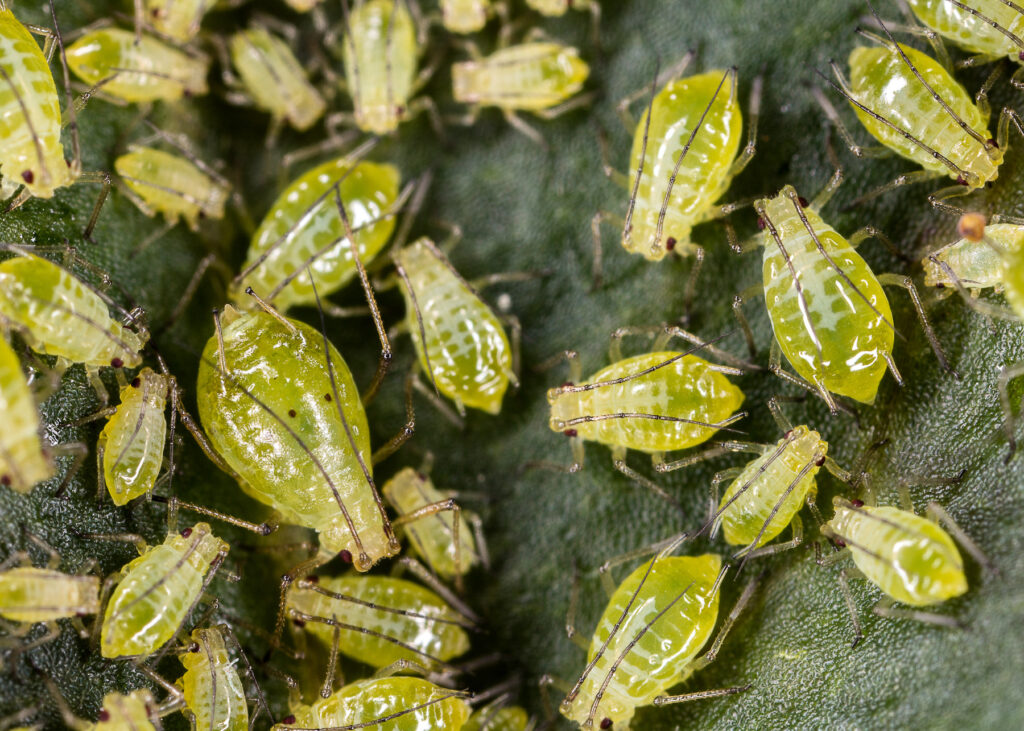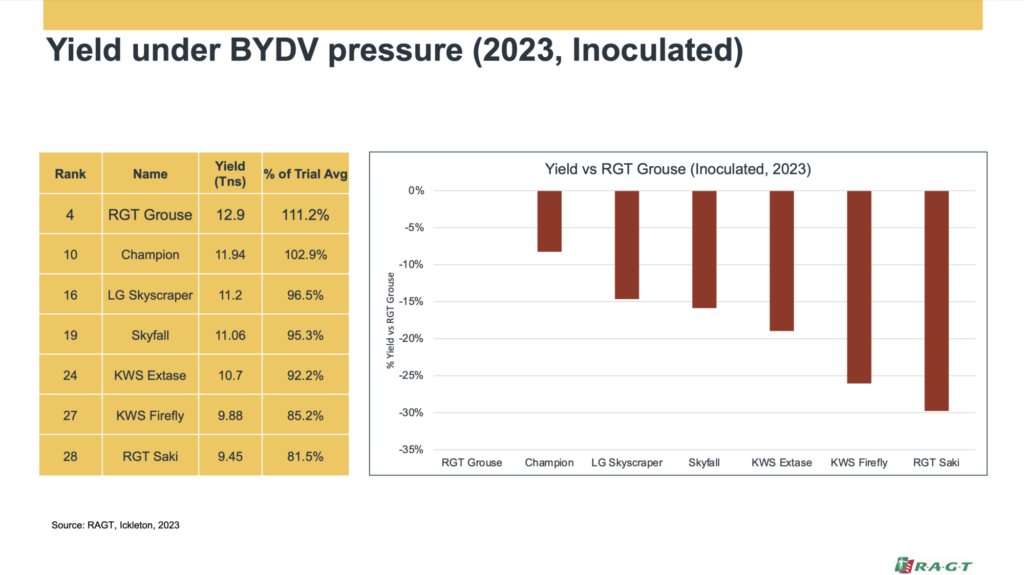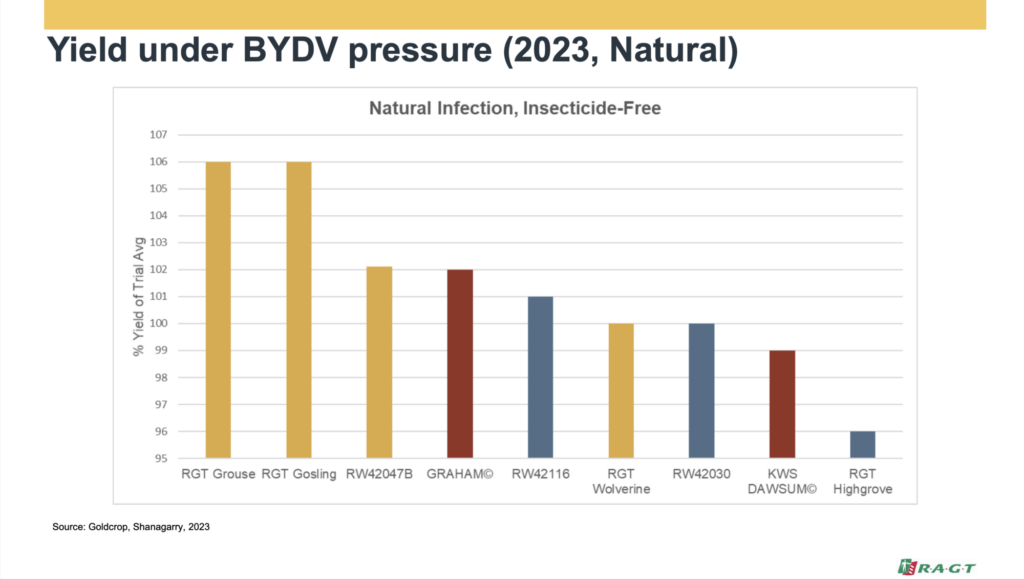Time to consider BYDV-resistant wheat as aphid threat increases
26th October 2023
Numbers of aphid vectors that transmit barley yellow dwarf virus are significantly higher than this time last year and are building rapidly, increasing the chances of an epidemic of the disease if mild weather continues.

The bird cherry-oat aphid is the main carrier of BYDV. During the week to 17th September, Rothamsted Research Insect survey trapped 8,298 of the pests, and a further 3,548 in the week to 24 September.
This takes the total since monitoring began in March to 23,405, which is already well above last year’s total (Mar-Nov) of 18,701. Grain aphids, which are also vectors of BYDV, number 2077 so far, compared with 2041 for 2022.
“Although 2022 was a relatively low aphid year, the mild weather allowed infection to continue across the country right through autumn and winter in most regions, triggering the T-sum for aphicide application four times across most parts of the UK,” says RAGT technical sales manager Dr Cathy Hooper.
“This season’s catch of bird cherry-oat aphids is actually tracking 2021, when over 94,500 of that species were caught, and we can expect numbers to build again over the next few weeks, especially looking at the weather forecast.”
Importantly, the number of cereal colonisers – winged asexual female aphids that migrate to cereal crops – is huge, running at 84% compared with the 10-year average of 41%.
“If we have another mild autumn and winter like last year, the threat of a disease epidemic is very real,” continues Dr Hooper.
“Many growers, not just those in the usual BYDV hotspots, could face another season of multiple insecticide applications and all the management and expense that entails, assuming they can travel with the sprayer.”
Obvious alternative
However, RAGT says more and more growers are discovering the benefits of growing the company’s Genserus (genetic security virus) wheats – Europe’s only commercially available wheats with BYDV resistance.
They offer an alternative to chemistry, as the resistance trait offers total control from planting to harvest.
Their potential has been clearly shown in a number of trials in the 2022/23 season, confirming several years of results in the UK and two decades of commercial production in Australia.
In RAGT’s own trials carried out at Ickleton, Cambridgeshire, seven Genserus varieties were compared against a range of popular and pipeline conventional varieties.
The trials received Recommended List-protocol fungicide and PGR treatments, but no aphicide at all. Plots were inoculated with four sets of BYDV-infected aphids at two-week intervals in the autumn and again in the spring.
All seven Genserus varieties significantly outyielded the conventional varieties (see Graph 1).

“This really shows how effective the resistance trait is,” says managing director Lee Bennett. “We’ve been trying to break it for years, but it still keeps delivering, leaving the competition in its wake in these high-pressure situations.”
A trial carried out in County Cork by Goldcrop, this time with natural BYDV infection only, also clearly demonstrated the strength of the BYDV resistance (see Graph 2). As at Ickleton, all plots received full fungi and PGR but no insecticide.

“Genserus varieties put in an impressive performance, taking the top three places, with RGT Grouse taking equal top spot at 106% of controls,” says Mr Bennett.
Genserus varieties have also performed well in AHDB RL trials where BYDV was confirmed or likely to have occurred, adds Mr Bennett. “It seems there’s definitely a Western pattern to the results.
“All varieties on all the sites will have been sprayed with aphicide, as per the RL protocol. So even where the conventional varieties are supported by insecticide, we’re seeing Genserus varieties more than holding their own in what are likely to be high-pressure situations.”
At the Glamorgan site, where AHDB has confirmed BYDV infection, RGT Wolverine came top out of 52 varieties, scoring 108% of controls, with RGT Grouse also doing very well, clinching a top 10 place on 105%.
In Shropshire, RGT Wolverine and RGT Grouse came second and third respectively, scoring 108% and 107% of controls. In Devon, the two varieties scored 113% and 108%.
RAGT is conducting further comprehensive trials this season, says Mr Bennett. “For harvest 2024 we’ve put in place a 17-site trial matrix dotted all over the Midlands, South and West and one in Ireland. We should have a big data pool next year.”
